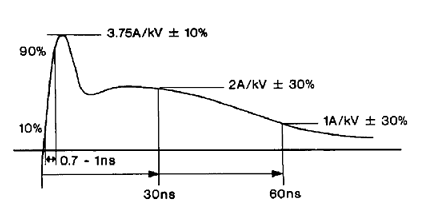| Test Equipment

ESD Testing IEC 61000-4-2
Latest Version IEC
61000-4-2:2008
ESD Background
Electrostatic Discharge (ESD) is the abrupt release of charge
from one object (often a person) to another. Such a discharge can permanently
damage or otherwise upset the function of sensitive electronic circuits.
Electronic products are tested for ESD immunity to insure
their continued reliable operation if subjected to realistic levels of ESD after
being placed in service. The European Union's EMC Directive mandates ESD
immunity testing for virtually all electrical and/or electronic products as a
condition for obtaining the CE Mark before shipping to a member state of the
European Union.
Applicable Standards
Generic Immunity Standards, Product Standards and Product
Family Standards require that ESD tests be performed in accordance with specific
Basic EMC Standards: IEC 801-2, IEC 61000-4-2, or EN 61000-4-2. Application Note, EMC Standards Overview, provides an overview of European
Standards for electromagnetic compatibility, describes how the Standards relate
to one another, and lists sources for procuring copyrighted documents.
Basic EMC Standard
The Basic EMC Standards for ESD define methods of
generating consistently reproducible electrical stresses for test purposes. They
specify capacitances and resistances to model the human body's charge storing
capability and discharge impedance, respectively. This model results in a
current waveform, defined in the Standards. While the Basic EMC Standard also
specifies how to perform ESD testing, the Generic, Product and Product Family
Standards specify the test levels and pass/fail Performance Criteria.
Test Levels
| ESD Test Levels (IEC/EN
61000-4-2) |
|
Contact discharge |
Air discharge |
| Level |
Test voltage |
Test voltage |
| 1 |
±2 kV |
±2 kV |
| 2 |
±4 kV |
±4 kV |
| 3 |
±6 kV |
±8 kV |
| 4 |
±8 kV |
±15 kV |
| x |
x |
x |
| x can be any level specified
in product specific standards |
|
Standard |
Applicability |
Contact Discharge
Test Voltage |
Air Discharge Test Voltage |
|
EN 50082-1 |
Generic Immunity - Residential, Commercial and Light
Industrial |
N/A |
8kV |
EN 50082-1
Draft |
Draft Generic Immunity - Residential, Commercial and Light
Industrial |
4kV |
8kV |
|
EN 50082-2 |
Generic Immunity - Industrial Environment |
4kV |
8kV |
|
EN 50082-2Draft |
Generic Immunity - Industrial Environment |
4kV |
8kV |
|
EN 55104 |
Immunity for Household Appliances, Tools and Similar
Apparatus |
4kV |
8kV |
Test Set-Up
Coupling Methods
Direct Coupling is a discharge directly to the Equipment Under
Test (EUT), either in an Air Discharge mode, necessary for products having few
or no metal surfaces, or via Contact mode, the preferred method. In the air
discharge mode, the ESD event is initiated when the test simulator output is
brought into close proximity with the EUT until a spark is initiated. The
resulting stress is influenced by various environmental factors. In the
preferred contact discharge mode, the test simulator output is first brought
into physical contact with the EUT, then the ESD event is initiated under
controlled conditions within the simulator.
Indirect Coupling simulates an ESD event which causes a
radiated field to be emitted in the vicinity of the victim equipment. This is
accomplished using Vertical Coupling Planes (VCP's) and Horizontal Coupling
Planes (HCP's). Current standards require discharges be made to the edge of the
VCP and surface of an HCP.
Waveforms

Waveform Verification
IEC 61000-4-2 requires the simulator output be verified
periodically. A Model CTC-3 measurement target and target plane is required. The
ESD current measurement is then made using a measurement system having a 1GHz or
greater bandwidth. It is necessary to place the oscilloscope inside a shielded
enclosure during the measurement to reduce the effects of radiated ESD directly
to the measurement instrument.
Recent work by the Working Group 14.0 of the ESD Association
has found that some simulators produce waveforms that are in compliance with IEC
61000-4-2, but have considerable ringing and high frequency components that do
not show up with 1GHz instrumentation. These simulators may cause failures in
products which would not occur if tested with a Thermo KeyTek simulator. Working
Group 14.0 is preparing a document to describe waveform verification methods to
allow manufacturers to verify the ESD current from simulators using high
bandwidth instrumentation.
Number and Rate of Discharges
The manufacturer is required to develop a test plan identifying
the EUT's most sensitive operating mode and appropriate test points. A minimum
of 10 discharges are then made to each test point in either Contact Discharge or
Air Discharge, according to the test plan. A recommended time interval of 1
second between tests should be used, but a longer interval is allowed if
necessary to determine if a system failure has occurred.
For the indirect tests, 10 discharges are required to the
Vertical Coupling Plane at each of 4 equipment faces (40 discharges) and then 10
discharges are required to the Horizontal Coupling Plane at 4 sides of the EUT
(40 discharges).
EUT Performance Criteria
For ESD tests, the Generic Immunity Standards and Household
Appliances Product Family Standard require that products operate as intended
after the test. No degradation or loss of function is allowed below a
performance level specified by the manufacturer. During the test, degradation is
allowed, but not a change in the actual operating state or stored data. Refer to
the tables located in the Generic, Product and Product Family Standards for
specific Performance Criteria. The product cannot become unsafe under any
conditions.
ESD Simulators
ESD Simulators meet all the simulator
requirements of IEC 61000-4-2, including discharge network characteristics,
discharge tips, and waveforms. Numerous accessories and discharge tips are
available for those manufacturers requiring additional test
capability and flexibility.
|

